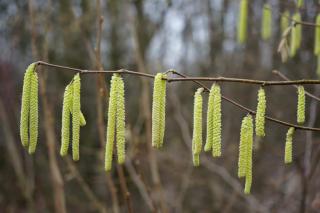

Corylus avellana, better known as the common hazelnut and more rarely aveline, is a shrub fruit tree that is very interesting for its blond or green hazelnuts.
Corylus avellana facts
Name – Corylus avellana
Family – Betulaceae
Type – fruit shrub
Height – 10 to 20 feet (3 to 6 meters)
Exposure – full sun
Soil – ordinary, well drained
Foliage – deciduous
Flowering – February to April
Harvest – fall
It is preferable to plant your Corylus avellana in fall to promote root development before winter.
But you can also plant it in any other season of the year, as long as you avoid high temperatures in summer and cold winter freezing.
It is critical that you plant 2 different varieties together to ensure fertilization and fruit-bearing. Check when purchasing your hazelnut trees that they belong to different species.
 The Corylus avellana is a shrub fruit tree that is very easy to care for and that requires practically no care at all.
The Corylus avellana is a shrub fruit tree that is very easy to care for and that requires practically no care at all.
Note that pruning isn’t really needed, but pruning at the end of winter, and keeping the Corylus avellana reasonably sized will increase the harvest.
If you wish to cut the tree back drastically, or prune the tree severely to even out the branches, never do it before the blooming which takes place from winter to spring, or else you won’t have any hazelnuts.
The hazelnuts are ready to be harvested when the fruit detaches from the branch and falls to the ground.
The hazelnut weevil or Curculio nucum enters the hazelnut and eats it up entirely.
That makes for quite a bad surprise when you realize your hazelnut is hollow!
 The name Corylus comes from latin root corulus, which is how the Romans called the hazelnut tree. That in turn came from earlier Greek Korus, which means “helmet”, because the cupula or hulls that surround the edible part of the nut look like a tiny finger helmet.
The name Corylus comes from latin root corulus, which is how the Romans called the hazelnut tree. That in turn came from earlier Greek Korus, which means “helmet”, because the cupula or hulls that surround the edible part of the nut look like a tiny finger helmet.
Corylus avellana must be planted together with another Corylus avellana so that hazelnuts may appear, this is necessary for fruit formation since a tree cannot self-pollinate.
So set it up in a shrub bed, or add it to your hedge, that will make your hedge even more ornamental and especially, productive!
Hazelnuts are always harvested in fall but even if hazelnuts are themselves the prime appeal of this large shrub, it also has a definite ornamental value thanks to its delicately formed colorful leaves.
Read also:
Remove suckers that grow from the base often to maximize productivity and ensure your Corylus avellana retains a beautiful bearing.